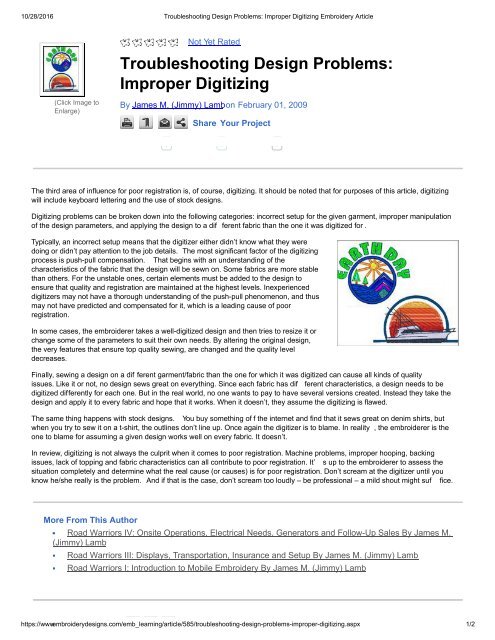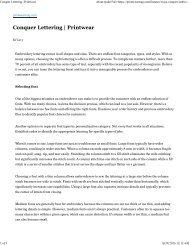Embroidery Basics Articles
You also want an ePaper? Increase the reach of your titles
YUMPU automatically turns print PDFs into web optimized ePapers that Google loves.
10/28/2016 Troubleshooting Design Problems: Improper Digitizing <strong>Embroidery</strong> Article<br />
(Click Image to<br />
Enlarge)<br />
Not Yet Rated<br />
Troubleshooting Design Problems:<br />
Improper Digitizing<br />
By James M. (Jimmy) Lamb on February 01, 2009<br />
Share Your Project<br />
0 0 0<br />
The third area of influence for poor registration is, of course, digitizing. It should be noted that for purposes of this article, digitizing<br />
will include keyboard lettering and the use of stock designs.<br />
Digitizing problems can be broken down into the following categories: incorrect setup for the given garment, improper manipulation<br />
of the design parameters, and applying the design to a dif ferent fabric than the one it was digitized for .<br />
Typically, an incorrect setup means that the digitizer either didn’t know what they were<br />
doing or didn’t pay attention to the job details. The most significant factor of the digitizing<br />
process is pushpull compensation. That begins with an understanding of the<br />
characteristics of the fabric that the design will be sewn on. Some fabrics are more stable<br />
than others. For the unstable ones, certain elements must be added to the design to<br />
ensure that quality and registration are maintained at the highest levels. Inexperienced<br />
digitizers may not have a thorough understanding of the pushpull phenomenon, and thus<br />
may not have predicted and compensated for it, which is a leading cause of poor<br />
registration.<br />
In some cases, the embroiderer takes a welldigitized design and then tries to resize it or<br />
change some of the parameters to suit their own needs. By altering the original design,<br />
the very features that ensure top quality sewing, are changed and the quality level<br />
decreases.<br />
Finally, sewing a design on a dif ferent garment/fabric than the one for which it was digitized can cause all kinds of quality<br />
issues. Like it or not, no design sews great on everything. Since each fabric has dif ferent characteristics, a design needs to be<br />
digitized differently for each one. But in the real world, no one wants to pay to have several versions created. Instead they take the<br />
design and apply it to every fabric and hope that it works. When it doesn’t, they assume the digitizing is flawed.<br />
The same thing happens with stock designs. You buy something of f the internet and find that it sews great on denim shirts, but<br />
when you try to sew it on a tshirt, the outlines don’t line up. Once again the digitizer is to blame. In reality , the embroiderer is the<br />
one to blame for assuming a given design works well on every fabric. It doesn’t.<br />
In review, digitizing is not always the culprit when it comes to poor registration. Machine problems, improper hooping, backing<br />
issues, lack of topping and fabric characteristics can all contribute to poor registration. It’ s up to the embroiderer to assess the<br />
situation completely and determine what the real cause (or causes) is for poor registration. Don’t scream at the digitizer until you<br />
know he/she really is the problem. And if that is the case, don’t scream too loudly – be professional – a mild shout might suf fice.<br />
More From This Author<br />
Road Warriors IV: Onsite Operations, Electrical Needs, Generators and FollowUp Sales By James M.<br />
(Jimmy) Lamb<br />
Road Warriors III: Displays, Transportation, Insurance and Setup By James M. (Jimmy) Lamb<br />
Road Warriors I: Introduction to Mobile <strong>Embroidery</strong> By James M. (Jimmy) Lamb<br />
Share this project:<br />
https://www.embroiderydesigns.com/emb_learning/article/585/troubleshootingdesignproblemsimproperdigitizing.aspx 1/2




